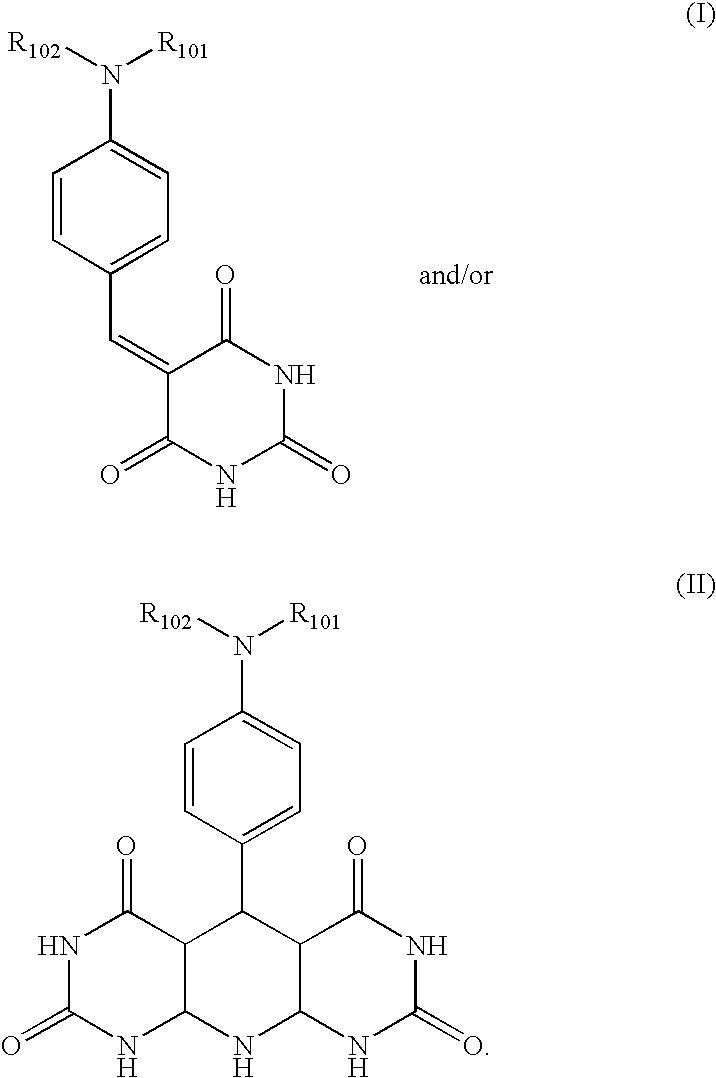Process for the preparation of a pigment comprising a core material and at least one dielectric layer
a technology of dielectric layer and core material, which is applied in the field of preparation of a pigment comprising a core material and at least one dielectric layer, can solve the problems of not being suitable for forming effect pigments with reflective metallic cores in the highly acidic environment, affecting the effect of pigments, and affecting the quality of pigments,
- Summary
- Abstract
- Description
- Claims
- Application Information
AI Technical Summary
Benefits of technology
Problems solved by technology
Method used
Image
Examples
example 2
0.5 g silicon oxide flakes, 150 g deionized water and 26.5 ml boric acid aqueous solution (0.8 M, 21.2 mmol) are stirred together to form a slurry. It is pumped in a continuous loop through a microwave oven. To the slurry is added 2 ml ammonium hexafluorostannate (0.1 M, 0.2 mmol) with syringe pump at the rate of 0.4 ml / min. 30 minutes after this addition, 50 ml ammonium hexafluorotitanate (0.2 M, 10.0 mmol) is added at the same rate. Another 30 minutes is allowed for the reaction to complete. The temperature is maintained at 50° C. during the entire process by adjusting the power level and operating time of the microwave. The solid is isolated from bulk solution by sediment and decantation. This solid is slurried with deionized water. Sedimentation and decantation are repeated. Finally, the solid is collected on a filtration funnel, washed with deionized water and dried. Further drying is carried out in vacuum oven at 110° C.
example 3
1 g silicon dioxide flakes, 375 g deionized water and 8 ml boric acid solution (0.8 M, 6.4 mmol) are stirred together to form a slurry. The slurry is pumped in a continuous loop through a microwave oven. To the slurry is added 2 ml ammonium hexafluorostannate (0.1 M, 0.2 mmol) with a syringe pump at a rate of 0.4 ml / min. 30 minutes after this addition, 15 ml ammonium hexafluorotitanate (0.2 M, 3.0 mmol) are added at the same rate and the reaction is continued for another 30 minutes until completion. The temperature is maintained at 50° C. during the entire process by adjusting the power level and operating time of the microwave oven. The solid is isolated from bulk solution by sedimentation and decantation. The solid is slurried with deionized water and the sedimentation and decantation is repeated. The solid is collected on a filtration funnel, washed with deionized water, dried and finally dried in a vacuum oven at 110° C.
example 4
1 g silicon dioxide flakes, 300 g deionized water and 14 ml boric acid solution (0.8 M, 11.2 mmol) are stirred together to form a slurry. The slurry is pumped in a continuous loop through a microwave oven. To the slurry is added 5 ml ammonium hexafluorostannate (0.1 M, 0.5 mmol) with syringe pump at a rate of 0.4 ml / min. 30 minutes after this addition, 25 ml ammonium hexafluorotitanate (0.2 M, 5.0 mmol) are added at the same rate and the reaction is continued for another 30 minutes until completion. The temperature is maintained at 50° C. during the entire process by adjusting the power level and operating time of the microwave. The solid is isolated from bulk solution by sedimentation and decantation. The solid is slurried with deionized water and the sedimentation and decantation is repeated. The solid is put on a filtration funnel, washed with deionized water, dried and finally dried in a vacuum oven at 110° C.
PUM
| Property | Measurement | Unit |
|---|---|---|
| thickness | aaaaa | aaaaa |
| thickness | aaaaa | aaaaa |
| index of refraction | aaaaa | aaaaa |
Abstract
Description
Claims
Application Information
 Login to View More
Login to View More - R&D
- Intellectual Property
- Life Sciences
- Materials
- Tech Scout
- Unparalleled Data Quality
- Higher Quality Content
- 60% Fewer Hallucinations
Browse by: Latest US Patents, China's latest patents, Technical Efficacy Thesaurus, Application Domain, Technology Topic, Popular Technical Reports.
© 2025 PatSnap. All rights reserved.Legal|Privacy policy|Modern Slavery Act Transparency Statement|Sitemap|About US| Contact US: help@patsnap.com


